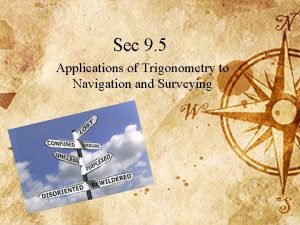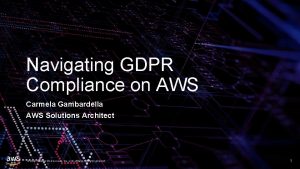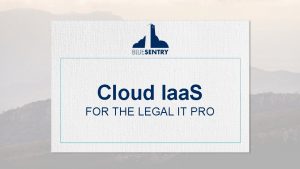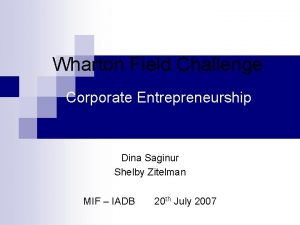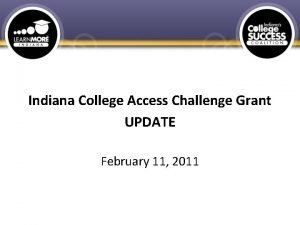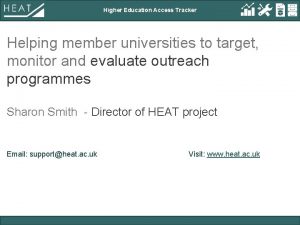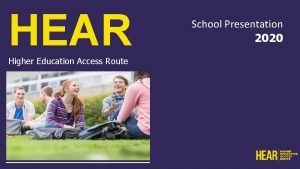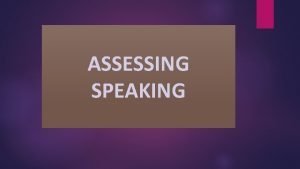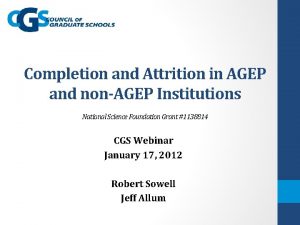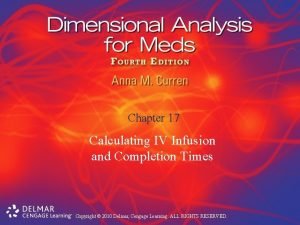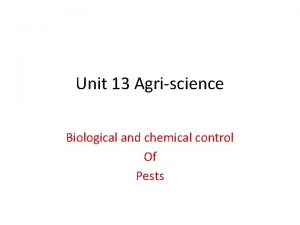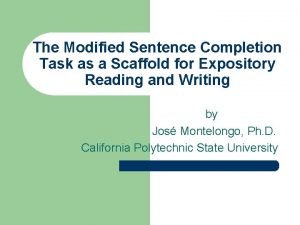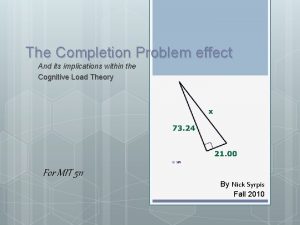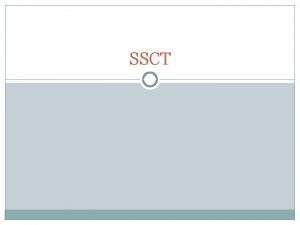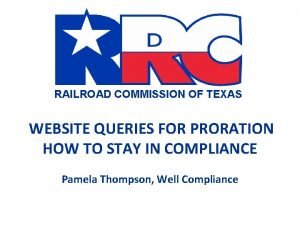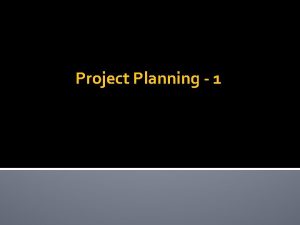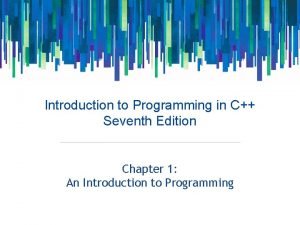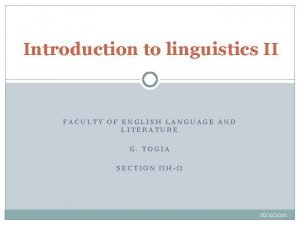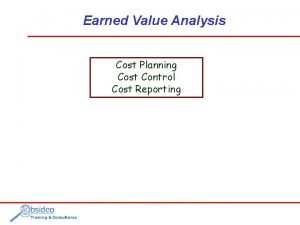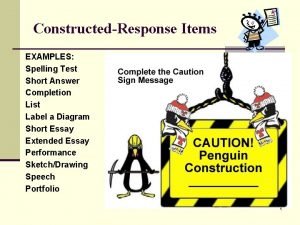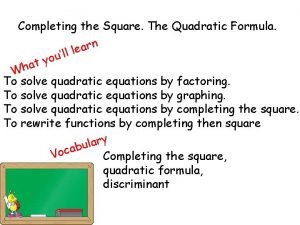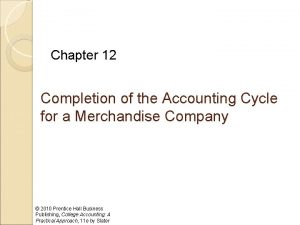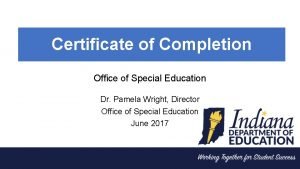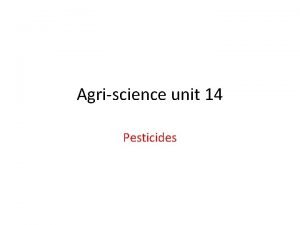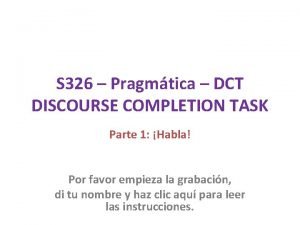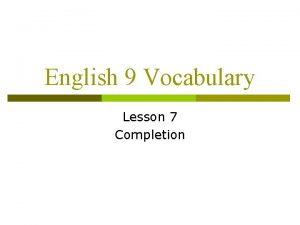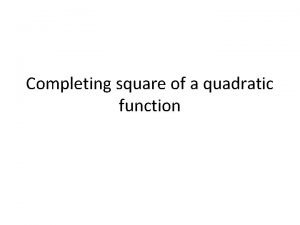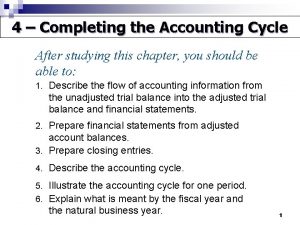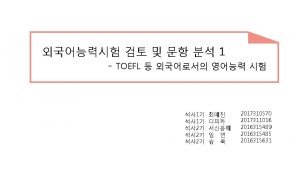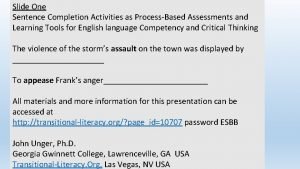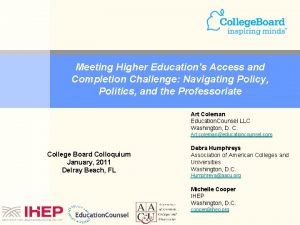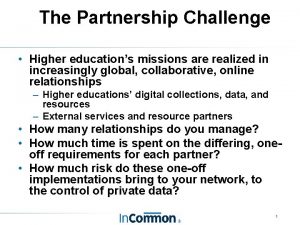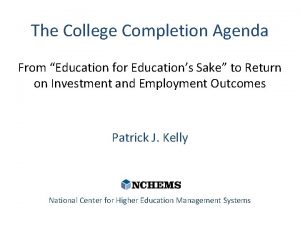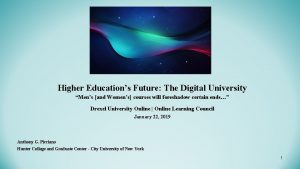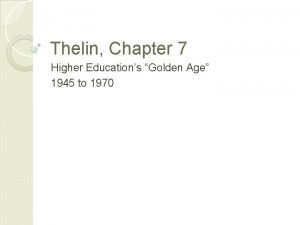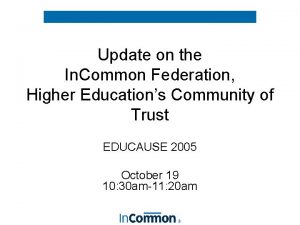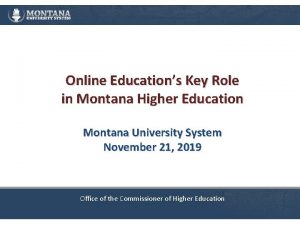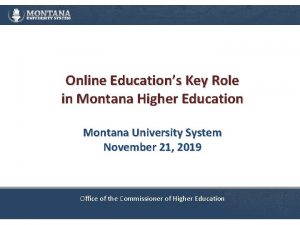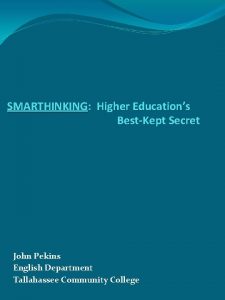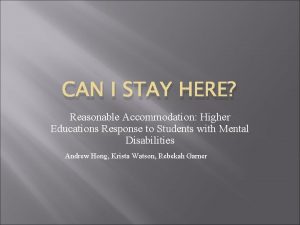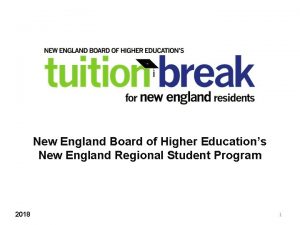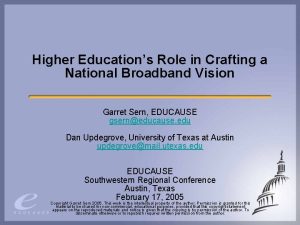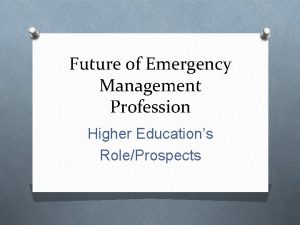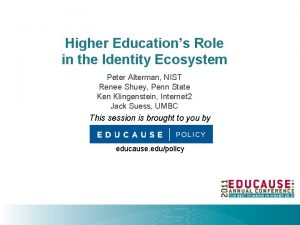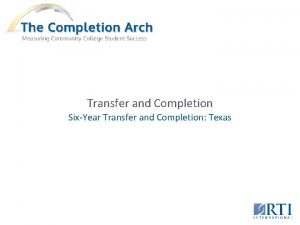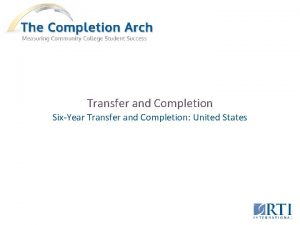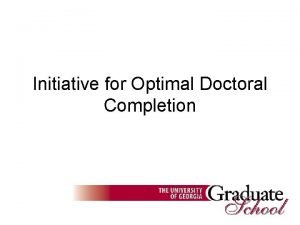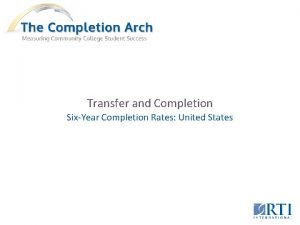Meeting Higher Educations Access and Completion Challenge Navigating

















































- Slides: 49

Meeting Higher Education's Access and Completion Challenge: Navigating Policy, Politics, and the Professoriate Art Coleman Education. Counsel LLC Washington, D. C. Art. coleman@educationcounsel. com College Board Colloquium January, 2011 Delray Beach, FL Debra Humphreys Association of American Colleges and Universities Washington, D. C. Humphreys@aacu. org Michelle Cooper IHEP Washington, D. C. cooper@ihep. org

Presentation Overview Session Objectives: Provide an overview of key national policy, political and academic issues, trends and projections relevant to higher education's ability to meet 21 st Century demands—all as a foundation for discussion about key action-oriented strategies to consider. Session Outline: I. Policy: The National and Federal Landscape II. Politics: Federal and State Developments and Trends III. Academe: Key Points for Discussion IV. Questions and Answers 2

I. Policy

The National Policy Context: Goals… R The President's Bold Goal: Have the highest proportion of college graduates in the world by 2020. q Why? q Economic Competitiveness q Citizenship Experiences and Skills q Expanded Opportunity q How? Ø Reframing the conversation—access and completion Ø Unprecedented Federal Investment in Major Reform Drivers Ø Movement Around Higher Education Accountability 4

The National Policy Context: The Drivers… q A National Focus on College and Career Readiness, with Major Systemic Implications (without action, there's a train wreck coming…) Ø Common state standards/Assessment consortia Ø P-20/Systems reexamination and action (e. g. , articulation agreements) q A Period of Federal Action, Reflection, and Action: The Swinging Pendulum of Reform: Ø Stimulus Funding: RTTT, I 3, etc. v Driver of major policy reform regarding TLE, data systems, etc. Ø ESEA reauthorization in the wake of NCLB Ø Budgets! …with a focus on financial aid/Pell; for-profit accountability q The International Picture: Shifting Tides Ø Concerns about U. S. competitiveness 5

Elementary and Secondary Education: Key Developments and Trends q College and Career Readiness Policy Frame Ø Common Core Standards v Adopted by 41 states—with major projected impact in postsecondary education v Significant work regarding assessment consortia v Key questions regarding Congress and ESEA reauthorization Ø Major systems focus v Data Systems v P-20 Lens Ø Continuing key questions on accountability v Transparency, student growth and disaggregation of data. v Increased focus on "the bottom 5 percent" of schools. q Teacher and Leader Effectiveness Ø Key questions on ways to link data to measures of teacher accountability Ø Huge implications for colleges of teacher education q Reforms and Innovations Ø Increased focus on charter and autonomous schools with Race to the Top. 6

Postsecondary Education: Key Developments and Trends q Heightened attention on access and completion agenda, with increasing focus on accountability and the "return on the dollar. " Ø Accountability points of focus include: v Transparency/Data v Federal Financial Aid • For-profit institution focus: The genie out of the bottle? v Outcomes • Assessing Results—for what purposes? • Reporting Results—what results? § Chairman Kline: The Department should ensure consumers have access to meaningful measures of student outcomes, including graduation rates, persistence rates, and in-field job-placement rates. 7

Across the Spectrum: Budgets q Congressional Work Incomplete: Fiscal Year 2011 Appropriations Ø Left unresolved, a nearly $6 billion Pell Grant shortfall. q Pressures for the New Congress Ø The National Commission on Fiscal Responsibility and Reform. Ø The House of Representatives Republican Pledge to America. Ø Movement to ban earmarks. q State Budgets Ø To balance 2011 budgets, states had to address gaps totaling $125 billion in 46 states. 8

Key Points of Policy Focus and Action Key Areas of Federal/National/State Focus Higher Education's Vital Role 1. • Systems Capacity and Alignment , Especially Data • Teacher & Leader Effectiveness • Investments in Systems/ Underperforming Districts & Schools • Investments in Community Colleges, etc. § Point to… Community College Connections 2. K-12 Connections. Enhance teacher/leader education and related K-12 support; and Invest in underperforming districts. 3. Direct Student Support. Early counseling ; and financial support for low-income families; etc. 4. Cost-cutting • Continuing Investment in Financial Aid • Promotion of Accountability Focus • Cost-cutting System Coherence and Connectivity. Support aligned standards, curriculum, assessments, data systems…coherence, as a basis for gauging results! The Bottom Line: Sustained, Systemic Change…. 9

II. Politics

The Federal and National Landscape Election Overview Ø House v Republicans add at least 60 seats to take control of House. v New breakdown: 239 R to 189 D. Ø Senate v Democrats keep control of Senate, but lose six seats. v New breakdown 53 D to 47 R to 2 Ind. Ø Governors v Republicans gain control of 8 additional governors mansions. v New breakdown 29 R to 20 D to 1 Ind. Ø State Legislatures v Republicans now control 54 legislative chambers. v Democrats have 38 and one is tied. 11

House Education Outlook q K-12: ESEA on hold until Republican caucus consensus emerges and transition logistics completed, but remains important objective. q Higher Ed: Intense for-profit scrutiny diminishes, but completion rate concerns linked to Pell/loans expand across higher ed. q Budget: Future education budgets held flat, state/local bailouts end, and new programs unfunded. q Possible Republican Committee Leadership: John Kline (MN)/Ed & Labor and Denny Rehberg (MT)/Labor HHS Ed Appropriations. q Possible Democratic Committee Leadership: Miller (CA)/Ed & Labor and Rosa De. Lauro (CT)/Labor HHS Ed Appropriations. 12

Senate Education Outlook q K-12: Bi-partisan ESEA negotiations continue, but new committee members face steep learning curve. q Budget: Future education budgets held flat, state/local bailouts end, and new programs unfunded. q Higher Ed: For profit scrutiny remains. q Possible Committee Leadership: Tom Harkin (IA) expected to continue to chair HELP and Labor, HHS, Ed Appropriations. Mike Enzi (WY) expected to remain HELP Ranking Member. Republican Ranking Member on Labor HHS, Ed Appropriations TBD. 13

The U. S. Supreme Court: Who's Who… 2003 GINSBURG STEVENS SOUTER BREYER O'CONNOR GRUTTER MAJORITY (2003) KENNEDY REHNQUIST SCALIA THOMAS GRATZ MAJORITY (2003) 2011 GINSBURG KAGAN SOTOMAYER BREYER ALITO KENNEDY ROBERTS SCALIA THOMAS SEATTLE S. D. MAJORITY (2007) 14

Federal Law Evolves, Clarifies… Three Decades of Admissions-Related U. S. Supreme Court Decisions Constitutional Admissions Individualized Review U. of Michigan Law Policy (2003) Unconstitutional Admissions Point System U. of Michigan Undergraduate Policy (2003) K-12 Student Assignment Seattle/ Louisville S. D. Plans (2007) Admissions Quota System Single-Sex Admissions U. of Cal. Davis Med. School Policy (1978) VMI Admissions Policy (1996) Harvard Undergraduate Policy (1978 and 2003) 15

Public Reaction ► State Policy Change on Race- and Gender-Conscious Preferences 16

(BTW: Evidence…Part of the Policy Equation)

Demographic Projections Contribution to the Nation's Change in Total High School Graduates Relative to 2004 -2005, by Region Source: WICHE 18

Demographic Projections Composition of Public High School Graduates in the US -- By Race/ Ethnicity, 2004 -2005 (Actual); 2009 -2010 and 2014 -2015 (Projected) Source: WICHE 19

Demographic Projections Composition of Public High School Graduates in the US - By Race/ Ethnicity, 2004 -2005 (Actual); 2009 -2010 and 2014 -2015 (Projected) Source: WICHE 20

Demographic Projections Composition of Public High School Graduates in the US - By Race/ Ethnicity, 2004 -2005 (Actual); 2009 -2010 and 2014 -2015 (Projected) Source: WICHE 21

Demographic Projections Cumulative Percent Change in US Public School Graduates -- Relative to 2004 -2005 by Race/Ethnicity Source: WICHE 22

The U. S. Pipeline… For Every 100 Low-Income Students Who Enter High School… Prepared by Jobs for the Future (November 2008 presentation). Source: Goldberger Susan. Doing the Math: What It Means to Double the Number of Low-Income College Graduates, Minding the Gap. Harvard Press & Jobs for the Future: Cambridge, MA, 2007 23

The U. S. Pipeline… 65 Graduate from High School… 24

The U. S. Pipeline… 41 Enroll in College… 25

The U. S. Pipeline… And 11 Graduate College… 26

Education Distribution Across Household Income: A New Reality Source: The Georgetown University Center on Education and the Workforce, 2010 27

Postsecondary Degree Attainment: Ages 25 -64 by Population Group Source: Lumina Foundation for Education, A Stronger Nation Through Higher Education, 2010 28

The Growing Demand for Higher Order Skills Source: Council on Competitiveness, Competitiveness Index 29

Employers’ Top Priorities For Student Learning Outcomes In College % saying two- and four-year colleges should place MORE emphasis on helping students develop these skills, qualities, capabilities, knowledge Effective oral/written communication Critical thinking/ analytical reasoning Knowledge/skills applied to real world settings Analyze/solve complex problems Connect choices and actions to ethical decisions Teamwork skills/ ability to collaborate Ability to innovate and be creative Concepts/developments in science/technology 30

Employers Assess the Potential Value of Emerging Educational Practices % saying each would help a lot/fair amount to prepare college students for success 84% Expecting students to complete a significant project before graduation that demonstrates their depth of knowledge in their major AND their acquisition of analytical, problem-solving, and communication skills (62% help a lot) 81% Expecting students to complete an internship or community-based field project to connect classroom learning with real-world experiences (66%) 81% Ensuring that students develop the skills to research questions in their field and develop evidence-based analyses (57%) 73% Expecting students to work through ethical issues and debates to form their own judgments about the issues at stake (48%) Source: Raising the Bar (AAC&U, 2010) 31

III. Academe: Key Points for Discussion

Access and Completion: Key Areas of Policy Focus Systems Alignment Compliance: Federal and State Law/ Accreditation cc Clear Goals & Objectives Educational Soundness: Valid Effective Scalable Political Will & Stakeholder Support *© Education. Counsel, 2010 33

Access and Completion: Flawed Policy Assumptions • Top “diversity” issue is increasing the number of minority students graduating from somewhere • Narrow training is enough for workplace success • Success=more grads in less time with less debt • Accreditation system can handle quality assurance if accreditors just “got tougher” • Earning credits=learning (all credits and learning experiences are of equality—or “good enough”) • If you graduate, you’ve had the educational experience you need and achieved all the most important outcomes 34

Three Propositions To Frame Our Conversation Federal, State, System and Institutional Policies Must: 1. Promote rigor in systemically aligned academic standards that are relevant to meet 21 st Century demands—inclusive of focusing on learning outcomes measurements calibrated to new economic and civic demands (outcomes rather than just outputs). 2. Fully serve all students in their quest for postsecondary education—with a particular focus on minority/firstgeneration/low-income students, and with the necessary academic, financial, and counseling infrastructures and support that will promote access and college completion. 3. Ensure that academic quality and student learning isn't sacrificed in the name of numbers and outcomes-driven pressures. 35

Getting It Right: Key Issues Clear Goals & Objectives Ø How to align and connect higher education policy with global and democratic aims of education? Ø How to increase the numbers of graduates while also increasing the skills, knowledge and cross-cutting capacities of those graduates? Ø In the overarching "accountability, accountability" conversation, how to ensure clarity with respect to: accountability for whom, by whom, based on what, at what cost, with what benefits and consequences? 36

Getting It Right: Key Issues Educational Soundness: Valid Effective Scalable Ø How can/should the common core standards movement affect college admissions…and efforts to expand access? Ø Can effective outcome measures be effectively established (and if so, how)… Ø …while preserving the diversity of higher education institutions and their ability to meaningfully pursue distinct missions? Ø …in ways that will meaningfully and validly reflect the quality of institutional instruction and corresponding student learning? Ø …based upon valid assessments of student achievement of the full set of essential learning outcomes—knowledge, skills, responsibilities, integrative and applied learning? 37

Getting It Right: Key Issues Compliance: Federal and State Law/ Accreditation Ø To meet the 21 st Century challenges associated with enrollment decisions, do federal/state rules need to change? Ø In light of the evolution of the issue of accountability for higher education, what is the proper role for accreditors? Ø Should the process and substance of accreditation change to better align with accountability policy directions—and if so, how? v E. g. , Public reporting of data and findings? 38

Getting It Right: Key Issues Systems Alignment Ø What are the proper roles for the federal and state governments with respect to requirements, incentives and funding? And how do those parameters vary among public, private, and private/forprofit institutions? Ø With respect to both access and completion Ø How can we incentivize the right practices and avoid incentivizing the wrong ones (e. g. , tracking into lowquality programs)? 39

Getting It Right: Key Issues Political Will & Stakeholder Support Ø How should we address the growing question of "what have you done for me lately? " and "Why did it cost so much? " Ø Are all key constituencies meaningfully part of the relevant conversation, as a foundation for building transparency, stakeholder understanding, and prospects for consensus with respect to future directions for higher education? If there are "process gaps, " what steps should be taken? 40

Three Global Questions To Frame Our Conversation 1. What are the consequences of focusing on student learning outcomes as part of an education reform agenda—and how do we avoid the undesired, unintended consequences while achieving desired goals? 2. What are the key parameters that should frame the national dialogue on the use of student learning outcomes and the drive for greater accountability—to ensure that the key policies are well understood and that reforms are appropriately paced and sequenced? 3. As a matter of process, q What should institutions "own? " What should be a focus of state or federal advocacy? q How can we most inclusively pursue policy action—ensuring that key stakeholders are a meaningful part of the conversation? 41

Narrow Learning is Not Enough The LEAP Essential Learning Outcomes Knowledge of Human Cultures and the Physical and Natural World Focused on engagement with big questions, enduring and contemporary Intellectual and Practical Skills Practiced extensively across the curriculum, in the context of progressively more challenging problems, projects, and standards for performance Personal and Social Responsibility Anchored through active involvement with diverse communities and realworld challenges Integrative Learning Demonstrated through the application of knowledge, skills, and responsibilities to new settings and complex problems

High Impact Practices Supporting Completion and Learning « First-Year Seminars and Experiences « Common Intellectual Experiences « Learning Communities « Writing-Intensive Courses « Collaborative Assignments and Projects « Undergraduate Research « Diversity/Global Learning « Service Learning, Community-Based Learning « Internships « Capstone Courses and Projects 43

High-Impact Practices: What The Evidence Shows • Increase engagement, time on task, and integrative skills • Correlated with levels of academic challenge, active and collaborative learning, student-faculty interaction • Correlated with higher GPA, higher retention rates, greater satisfaction rates • Student learning outcomes—increased critical thinking, communications, and ethical reasoning • Impact for all students; greater impact for less well-prepared students and students of color. 44

Efficient Policies That Lead to Quality and Completion • Educational and support practices that work for all students, including underprepared students; • Practices that increase learning and retention • Practices that teach content and skills in integrative ways (allowing reduction of credit accumulation) • Assessment practices that both measure and deepen learning—and assess integrative projects

Key Campus Challenges • Going Deeper with Learning Outcomes – As the Lumina Foundation Now Intends to Do • Building High Impact, High Effort, High Pay-off Practices Early and Often into the Expected Curriculum • Taking “Information Delivery OUT of the Regular Classroom” – via the Power of New Technologies • Making Applied CENTRAL to the Educational Experience and the Catalyst for Developing Capabilities and The Context for Assessing Learning Outcomes

Other Lessons from LEAP • Faculty are key to improved learning outcomes; must play a role in creating and delivering curricula, and developing meaningful assessments • Cross-cutting outcomes are important and must be developed across both general education and the major; curricular coherence matters (random earning of credits isn’t enough) • Coherent vision and clear communication from top to bottom can have huge impact • Employers are key allies

Contact Information q Art Coleman, Education. Counsel co-managing partner, previously served as Deputy Assistant Secretary for Civil Rights in the U. S. Department of Education and has led the work of the College Board's Access and Diversity Collaborative since 2004. Mr. Coleman is also Chairman of the Board for the Institute for Higher Education Policy [IHEP]. He may be reached at art. coleman@educationcounsel. com. q Michelle Cooper, Ph. D is President of IHEP and a member of the board of directors for College Bound, National College Access Network, and Washington Center for Internships and Academic Seminars. Mrs. Cooper oversees IHEP's expansive research portfolio and innovative programmatic activities focusing on access and success, accountability, diversity, finance, and global impact. She may be reached at cooper@ihep. org. q Debra Humphreys, Ph. D is Vice President for Communications and Public Affairs for AAC&U, where she oversees all public affairs programs and outreach, media relations, marketing, and publishing. She is also currently leading national advocacy efforts as part of AAC&U's campaign, Liberal Education and America’s Promise: Excellence for Everyone as a Nation Goes to College. She may be reached at Humphreys@aacu. org. 48

Organizational Background q AAC&U is a leading national association concerned with the quality, vitality, and public standing of undergraduate liberal education. Founded in 1915, AAC&U now comprises more than 1, 200 member institutions--including accredited public and private colleges and universities of every type and size. q Education. Counsel LLC supports education leaders in their efforts to develop and implement policies to improve student achievement, close achievement gaps and ensure equal access to opportunity for all. Education. Counsel has offices in Washington, Atlanta, Chicago, and Greenville, SC; with affiliate offices in Boston, Raleigh, Tallahassee and Columbia, SC. q IHEP is a nonpartisan global research and policy center that serves as a resource for government agencies, higher education organizations, philanthropic foundations, and others committed to increasing access and success in postsecondary education. q For resources generated by the College Board's Access & Diversity Collaborative, please visit: www. collegeboard. com/accessanddiversity. 49
 Pearson educations
Pearson educations Teen challenge nottingham
Teen challenge nottingham Navigating the body muscular system #2
Navigating the body muscular system #2 Navigating the digital landscape
Navigating the digital landscape Cadet rule in navigation
Cadet rule in navigation Applications of trigonometry in navigation
Applications of trigonometry in navigation Amazon web services gdpr
Amazon web services gdpr Navigating the art world
Navigating the art world Aws iaa
Aws iaa What is meeting and types of meeting
What is meeting and types of meeting What is meeting and types of meeting
What is meeting and types of meeting Dina sleby
Dina sleby College access challenge grant
College access challenge grant For today's meeting
For today's meeting Proposal kickoff meeting agenda
Proposal kickoff meeting agenda Higher education access tracker
Higher education access tracker Higher education access route
Higher education access route What is the example test for imitative speaking skill?
What is the example test for imitative speaking skill? Doctoral initiative on minority attrition and completion
Doctoral initiative on minority attrition and completion Calculating infusion time and completion time calculator
Calculating infusion time and completion time calculator Terminal access controller access control system plus
Terminal access controller access control system plus Terminal access controller access-control system
Terminal access controller access-control system Subsea well completions
Subsea well completions Agriscience unit 13 completion answers
Agriscience unit 13 completion answers Sentence completion activity
Sentence completion activity Completion problem effect
Completion problem effect Sentence completion test
Sentence completion test Ba_ba_bac_bac_acb_cbac
Ba_ba_bac_bac_acb_cbac Suncg
Suncg Texas railroad commission online query
Texas railroad commission online query Adequate planning leads to the correct completion of work
Adequate planning leads to the correct completion of work The selection structure is the completion of
The selection structure is the completion of Completion point linguistics
Completion point linguistics Estimate at completion
Estimate at completion Completion items
Completion items Completing the square vs quadratic formula
Completing the square vs quadratic formula Complete square formula
Complete square formula Percentage of completion method
Percentage of completion method Completion of the accounting cycle
Completion of the accounting cycle Chapter 11 completion activity
Chapter 11 completion activity Certificate of completion special education
Certificate of completion special education Agriscience unit 14 completion answers
Agriscience unit 14 completion answers Dct
Dct Seguro completion bond
Seguro completion bond Lesson 7 sentence completion
Lesson 7 sentence completion Accounting cycle worksheet
Accounting cycle worksheet Complete a square formula
Complete a square formula Accounting cycle
Accounting cycle Task completion email sample
Task completion email sample Sentence completion activity
Sentence completion activity





